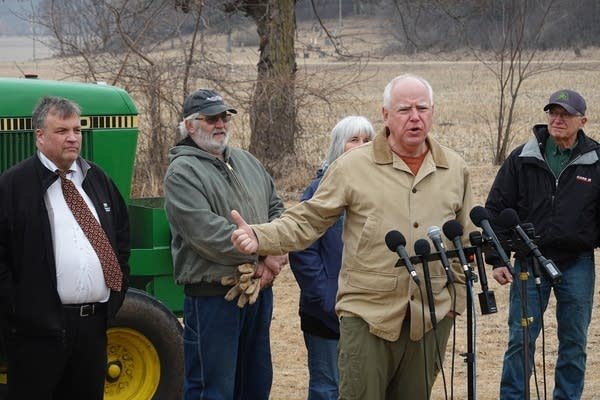
The Price of Protection: Analyzing Trump’s Promise to Farmers
Trump’s tariffs on agriculture led to immediate price drops and forced $28 billion in taxpayer-funded aid to farmers. While some saw it as relief, others criticized it as a temporary political fix. As the possibility of new tariffs arises, questions remain: will future policies prioritize long-term solutions or repeat short-term bailouts?
The ramifications of Trump’s trade policies on farmers, the financial aid that followed, and the implications for future agricultural policies.
When Donald Trump took office, many wondered how his approach to trade would influence America’s farmers. Fast forward to now, and Trump often boasts about the $28 billion in taxpayer aid aimed at supporting agricultural workers who were affected by his tariffs. But is this a benefit or just a band-aid on a much larger issue? Let’s delve into how his promises impact the agricultural community now and, in the future, and what that means for taxpayers and farmers alike.
The Impact of Trump’s Tariffs on Farmers
Overview of the Initial Tariffs
In 2018, President Trump introduced a series of tariffs aimed at protecting American industries. The goal was simple: to reduce the trade deficit and encourage domestic production. However, these tariffs had unintended consequences, especially for farmers. The tariffs targeted over 3,000 categories of goods, including many agricultural products. This move was meant to pressure countries like China into fairer trade practices. But did it really work?
Personal Accounts from Farmers
Farmers across the nation experienced a whirlwind of emotions due to these tariffs. Many felt the impact almost immediately. For instance, one local farmer shared,
“It felt like a rollercoaster; one moment we were thriving, and the next it all changed overnight.”
This sentiment was echoed by numerous farmers who relied heavily on export markets.
As tariffs increased, the prices of crops like soybeans and corn plummeted. Farmers who had planned their budgets based on stable prices suddenly found themselves in dire straits. Some reported losing contracts with international buyers. Others faced storage issues as they could not sell their harvests. The financial strain was palpable.
Mixed Feelings About Aid
In response to the turmoil, the government allocated a staggering $28 billion in taxpayer aid to support farmers. While some viewed this aid as a necessary lifeline, others criticized it as a temporary fix. They argued that it did not address the root causes of their struggles. Instead, it merely masked the problem.
- Some farmers appreciated the assistance, seeing it as a way to keep their operations afloat.
- Others felt it was a band-aid solution that did not provide long-term stability.
This division in opinion highlights the complexity of the situation. Farmers are resilient, but they also need sustainable solutions. The aid may have helped in the short term, but what about the future?
Long-Term Effects on Agricultural Pricing
The long-term effects of Trump’s tariffs on agricultural pricing and supply chains are still unfolding. Prices for many crops have not fully recovered. Farmers are left wondering if they can trust the market again. With export markets disrupted, many have had to pivot their strategies. Some are exploring new crops or markets, while others are simply trying to survive.
Moreover, the tariffs have altered supply chains. Farmers who once relied on international buyers now face a more localized market. This shift can be both a blessing and a curse. On one hand, it encourages local consumption. On the other, it limits the potential for growth. Farmers are caught in a balancing act, trying to navigate these changes while maintaining their livelihoods.
Trump’s tariffs have had a profound impact on American agriculture. The immediate financial distress felt by farmers has led to a reevaluation of their business models. As they adapt to new realities, the question remains: how will they thrive in a post-tariff world?
Evaluating Aid: Boon or Bane?
The debate surrounding agricultural aid is complex. On one hand, it is designed to support farmers in times of need. On the other hand, it raises questions about dependency and long-term sustainability. Is this aid truly beneficial, or is it merely a political tool? Let’s explore this multifaceted issue.
Does Aid Truly Benefit Farmers?
Many farmers find themselves in a precarious situation. After the implementation of tariffs, a staggering 82% of farmers reported reliance on government aid. This statistic raises an important question: Are these funds genuinely helping farmers, or are they creating a cycle of dependency?
Some argue that aid is a necessary lifeline. It provides immediate relief during crises, such as natural disasters or market fluctuations. However, others see it as a political maneuver. Politicians often tout these funds as a way to gain favor with rural voters. For instance, former President Trump claimed he “rewarded” farmers with $28 billion in taxpayer aid after imposing tariffs. This raises eyebrows. Is the aid a genuine effort to support farmers, or is it a strategy to secure votes?
Accountability in Aid Utilization
Another critical aspect of this discussion is accountability. How are these aid funds being utilized by farmers? Are they being invested in sustainable practices, or are they simply covering immediate costs? The lack of transparency in how aid is spent can lead to misuse and inefficiency.
- Farmers need to demonstrate how they are using aid funds.
- There should be clear guidelines on spending to ensure funds are used effectively.
- Regular audits could help maintain accountability.
Without proper oversight, there is a risk that aid could perpetuate poor farming practices. Farmers might rely on these funds instead of seeking long-term solutions. As one agricultural economist put it,
“Aid should empower, not create dependency.”
Alternative Support Methods
While government aid has its place, experts argue for more structural solutions. These alternatives could provide farmers with the tools they need to thrive without relying on aid. Some potential methods include:
- Education and Training: Providing farmers with knowledge about sustainable practices can lead to better long-term outcomes.
- Access to Resources: Ensuring farmers have access to seeds, equipment, and technology can help them become more self-sufficient.
- Market Access: Creating better pathways for farmers to sell their products can reduce reliance on aid.
Most economists believe that implementing sustainable practices could reduce the need for aid by 40%. This statistic highlights the importance of investing in long-term solutions rather than temporary fixes.
The Long-Term Impact of Aid
While aid may seem beneficial in the short term, its long-term impacts can be detrimental. Farmers may become accustomed to receiving aid, leading to a lack of innovation and adaptation. This reliance can stifle growth and hinder the development of sustainable farming practices.
Moreover, the political implications of aid cannot be ignored. When aid is used as a tool for political gain, it can undermine the very farmers it aims to support. The focus shifts from empowering farmers to securing votes. This shift can lead to policies that are not in the best interest of agricultural health.
In conclusion, the evaluation of agricultural aid is a nuanced topic. While it provides immediate relief, it also raises questions about dependency, accountability, and long-term sustainability. As the agricultural landscape continues to evolve, it is crucial to consider how aid can be structured to truly benefit farmers without creating a cycle of reliance.
Future Implications for Agricultural Policy
The landscape of agricultural policy is shifting. Farmers are caught in a web of uncertainty, especially with the looming threat of new tariffs. What does this mean for their future? As trade dynamics evolve, several factors will influence agricultural policies. Understanding these elements is crucial for farmers and policymakers alike.
Potential Further Tariffs and Promised Support: What’s Next for Farmers?
Farmers have faced significant challenges in recent years. Tariffs imposed on agricultural exports have created a ripple effect. The projected increases in tariffs could affect 25% of U.S. agricultural exports. This is not just a statistic; it represents real losses for farmers who depend on these markets.
In response to these challenges, past administrations have provided support. For instance, during previous tariff disputes, the government allocated $28 billion in taxpayer aid to farmers. This kind of support is vital. However, it raises questions: Will future administrations continue this trend? Will they be able to provide the same level of support?
As one agriculture policy analyst stated,
“If we don’t stabilize our farmer support, we risk losing a critical American industry.”
This sentiment underscores the urgency of the situation. Farmers need assurance that they will not be left to fend for themselves amidst fluctuating trade policies.
Factors Influencing Future Agricultural Policies Amidst Changing Trade Dynamics
Several factors will shape the future of agricultural policies. First, the political landscape plays a significant role. Trade deals can change with the political tides. A new administration may prioritize different trade relationships, impacting farmers significantly. This unpredictability can be daunting.
Second, global market trends are also influential. As countries negotiate trade agreements, the focus often shifts. Will local agriculture be prioritized, or will global trade considerations take precedence? Farmers are left wondering where they fit into this equation.
Lastly, sustainability is becoming a key factor in agricultural policy. Future policies could include stricter regulations or incentives for sustainable farming practices. This shift is essential for the environment but may also require farmers to adapt quickly. How will they manage these changes?
The Importance of Protecting Local Agriculture Versus Global Trade Considerations
Local agriculture is the backbone of many communities. It provides jobs, sustains local economies, and ensures food security. However, the push for global trade can sometimes overshadow these local needs. Policymakers must find a balance.
Protecting local agriculture is not just about economics; it’s about preserving a way of life. Farmers often have deep roots in their communities. They understand the land and its needs. Yet, they also face competition from international markets. This duality creates a complex challenge.
As trade dynamics shift, the importance of local agriculture cannot be overstated. Policymakers must consider how their decisions impact local farmers. Will they prioritize global trade at the expense of local needs? Or will they find a way to support both?
The future of agricultural policy is uncertain, but one thing is clear: farmers need support. With potential further tariffs on the horizon, the stakes are high. The balance between protecting local agriculture and engaging in global trade is delicate. Policymakers must navigate these waters carefully. As they do, they must remember the words of the agriculture policy analyst: stabilizing farmer support is crucial. Without it, the very foundation of American agriculture could be at risk.
TL;DR: Trump’s tariffs heavily impacted farmers, leading to $28 billion in taxpayer-funded aid. As he considers future tariffs, the sustainability of support for farmers is in question.
GovernmentSupport, TradePolicy, TaxpayerMoney, FarmerAid, TrumpTariffs, EconomicImpact, USAFarmers, AgriculturePolicy
#AgriculturePolicy, #EconomicImpact, #TradePolicy, #FarmerAid, #GovernmentSupport, #TrumpTariffs, #TaxpayerMoney, #USAFarmers,##TrumpTariffs, #FarmAid, #AgriculturalPolicy, #TradeWar, #TrumpEconomy, #USFarmers, #TariffImpact, #RuralAmerica, #Subsidies, #2024Elections

